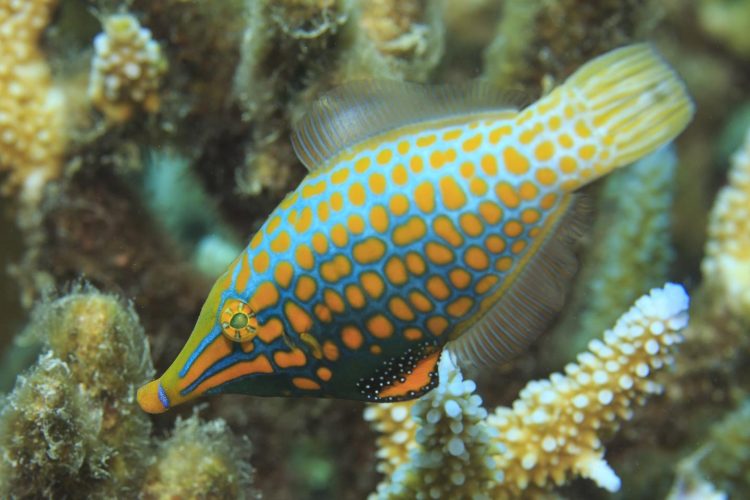Fish use chemical camouflage from diet to hide from predators

A filefish, pictured here, can create chemical camouflage by feeding on coral reefs. Credit: Credit: Tane Sinclair-Taylor
Filefish evade predators by feeding on their home corals and emitting an odor that makes them invisible to the noses of predators, the study found. Chemical camouflage from diet has been previously shown in insects, such as caterpillars, which mask themselves by building their exoskeletons with chemicals from their food. The new study shows that animals don't need an exoskeleton to use chemical camouflage, meaning more animals than previously thought could be using this survival tactic.
“This is the very first evidence of this kind of chemical crypsis from diet in a vertebrate,” said Rohan Brooker, a post-doctoral fellow in the School of Biology at the Georgia Institute of Technology in Atlanta. “This research shows that you don't need an exoskeleton that for this kind of mechanism to work.”
The study was published December 10 in the journal Proceedings of the Royal Society B. The study was sponsored by the ARC Centre of Excellence for Coral Reef Studies and the Ecological Society of Australia. The work was done as a part of Booker's doctoral research at James Cook University in Australia.
Anyone who has watched a nature documentary has seen insects that camouflage themselves as sticks, protecting the insects against predators that use vision to hunt for prey. But many animals see the world through smell rather than sight, and cunning critters from among them have adapted clever ways of smelling like their surroundings. A certain species of caterpillar, for example, smells like the plant that it lives on and eats. The caterpillar incorporates chemicals from the plant into its exoskeleton. Ants hunting for the caterpillar will walk right over it, none the wiser.
For the new study, researchers traveled to Australia's Lizard Island Research Station in the Great Barrier Reef, where they collected filefish. To show that filefish smelled like their home coral, the researchers recruited crabs to sniff them out. The filefish were fed two different species of coral; each species of coral is home to a unique species of crab. The crabs were given a choice between a filefish that had been fed the crab's home coral and a filefish that had been fed a coral that is foreign to the crab. The crabs always sought the filefish that had been feeding on the crabs home coral. The filefish smelled so strongly of coral that sometimes the crabs were attracted to the fish instead of coral, when given a choice between the two.
“We can tell that there is something going through the filefish diet that's making the fish smell enough like the coral to confuse the crabs,” Booker said.
To see if the chemical camouflage gives the filefish an evolutionary advantage to evade predators, the researchers tested cod to see how they responded to filefish that had been fed various diets. Cod, filefish and corals were put in a tank, with the filefish hidden from the cod. When the filefish diet didn't match the corals in the tank, the cod were restless, suggesting that they smelled food. When the filefish diet matched the corals in the tank, the cod stayed tucked away in their cave inside the tank.
The next step in the project is to learn how filefish can smell like coral without the benefit of an exoskeleton. Some evidence shows that amino acids in the mucus of fish – where much of their smell originates – will match their diet, but much work remains to tease apart this pathway.
“We have established that there is some kind of pathway from filefish diet to filefish odor,” Booker said. “This is just the first study. There's a lot of work still to be done to understand how it works.”
Booker is now working in the lab of Danielle Dixson, an associate professor of biology at Georgia Tech.
This research is supported by the ARC Centre of Excellence for Coral Reef Studies and the Ecological Society of Australia. Any conclusions or opinions are those of the authors and do not necessarily represent the official views of the sponsoring agencies.
CITATION: Rohan Brooker, et al., “You are what you eat: diet-induced chemical crypsis in a coral-feeding fish.” (Proceedings of the Royal Society B, December 2014). http://rspb.royalsocietypublishing.org/content/282/1799/20141887
Research News
Georgia Institute of Technology
177 North Avenue
Atlanta, Georgia 30332-0181 USA
@GTResearchNews
Media Relations Contacts:
Brett Israel (@btiatl) (404-385-1933) (brett.israel@comm.gatech.edu) or
John Toon (404-894-6986) (jtoon@gatech.edu)
Writer: Brett Israel
Media Contact
All latest news from the category: Life Sciences and Chemistry
Articles and reports from the Life Sciences and chemistry area deal with applied and basic research into modern biology, chemistry and human medicine.
Valuable information can be found on a range of life sciences fields including bacteriology, biochemistry, bionics, bioinformatics, biophysics, biotechnology, genetics, geobotany, human biology, marine biology, microbiology, molecular biology, cellular biology, zoology, bioinorganic chemistry, microchemistry and environmental chemistry.
Newest articles

Properties of new materials for microchips
… can now be measured well. Reseachers of Delft University of Technology demonstrated measuring performance properties of ultrathin silicon membranes. Making ever smaller and more powerful chips requires new ultrathin…

Floating solar’s potential
… to support sustainable development by addressing climate, water, and energy goals holistically. A new study published this week in Nature Energy raises the potential for floating solar photovoltaics (FPV)…

Skyrmions move at record speeds
… a step towards the computing of the future. An international research team led by scientists from the CNRS1 has discovered that the magnetic nanobubbles2 known as skyrmions can be…





















